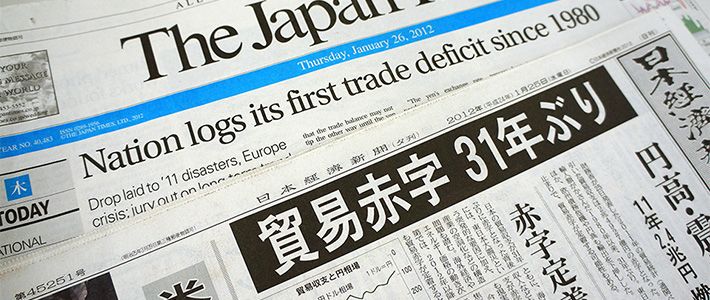
Current Account Surpluses Likely to Continue
Economy- English
- 日本語
- 简体字
- 繁體字
- Français
- Español
- العربية
- Русский
In 2011, Japan’s trade balance registered a deficit for the first time in 31 years. This has sparked a lively debate about the nation’s ability to retain a surplus in its current account. Some market participants argue that the surplus will dwindle and may turn into a deficit in just two or three years. At Morgan Stanley MUFG Securities Co., Ltd. we do not subscribe to that view, however. It is difficult to say precisely how long the current account will remain in the black, but in any case a modest amount of red ink in the trade balance will not easily produce current account deficits in Japan’s case. This is because Japan is by far the world’s largest holder of net foreign assets—in excess of ¥250 trillion. These assets produce a steady inflow of dividends, interest payments, and other such income gains, which are recorded in the income balance of the current account and can offset deficits in the trade balance. With surpluses in the current account building up year after year, net foreign assets are also accumulating through a positive feedback loop.
According to a rough estimate, the current account surpluses can be expected to last at least another 10 or 20 years. One market implication of this is that, for the foreseeable future, the government will be able to cover its budget deficits by relying solely on domestic funds. Long-term interest rates should, accordingly, hold steady at a low level.
Factors Producing Black Ink
A number of factors are working together to make it unlikely that the current account will fall into a deficit. First, Japan’s exports have remained buoyant; a fact that runs counter to the assumption that exports would decline in the wake of shifting manufacturing oversees to respond to the yen’s record high exchange rate. This positive outcome is a result of the strength of Japan’s capital goods and raw materials, and its proximity to Asian neighbors. Companies have indeed been steadily moving an increasing share of their production overseas, but statistics show that Japanese exports continued to expand during this same period (Figure 1).
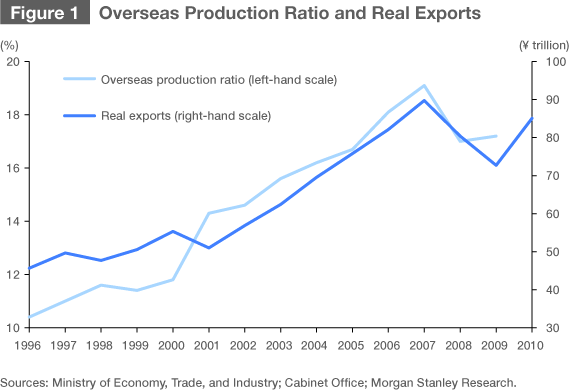
A second factor, on the import side, is related to energy. It is true that there will be an increase in imports of energy resources now that Japan’s nuclear power stations are out of operation, and this will negatively impact the country’s current account. But the value of these additional imports, at worst, will not exceed about 1% of Japan’s gross domestic product. Energy imports alone are thus unlikely to produce a large recurring deficit in the trade balance.
Third, in the income account, a large portion of the outflow from Japan consists of dividend payments, which play a cushioning role because they can be reduced during a business downturn. Structurally, they are a countercyclical factor, reducing the impact of swings in the business cycle. In addition, the inflow into Japan from the more than ¥250 trillion in net foreign assets tend to remain relatively stable despite changes in overseas interest rates. Given these circumstances, Japan’s income account has a strong tendency to stay in the black.
Fourth, the excess of savings in the private sector’s saving-investment ratio is likely to last. There has been a popular assumption that the graying of Japanese society will force families to tap into their savings, but in fact the household saving rate has tended to increase or at least hold steady. Corporate savings have also been sustained despite the deflationary conditions. Why has the household saving rate not fallen even as Japan’s population gets older? One possible answer may be that senior citizens are continuing to build up savings even after retirement, reflecting their serious concerns about the future.
Resilience of Income Account Surpluses
Among the foregoing factors, the black ink in the income account may be undermined by the recent downward movement in overseas interest rates. The investment yield on foreign assets is currently somewhat under 3%, but many economists expect future yields to fall due to the downtrend in long-term interest rates. If we look, for instance, at the foreign securities in foreign exchange reserves, which are part of net foreign assets, we find that many are longer-term securities; by maturity composition, 56.6% are from one year to less than five years, 26.7% are for five years or more, and only 17.7% are for under one year. We may take it for granted that many of them are investments in US Treasuries. The five-year interest rate in the United States is currently in the vicinity of 1%. If we use the simple assumption that when the securities mature they will be reinvested in instruments with the same maturity period, we find that average investment returns will fall to the level of 1% within five years from now.
It needs to be noted, though, that the black ink in the income account has proven to be fairly impervious to the downtrend in US long-term interest rates over the past 20 years or so (Figure 2). The underlying cause of this can be summed up in two points.
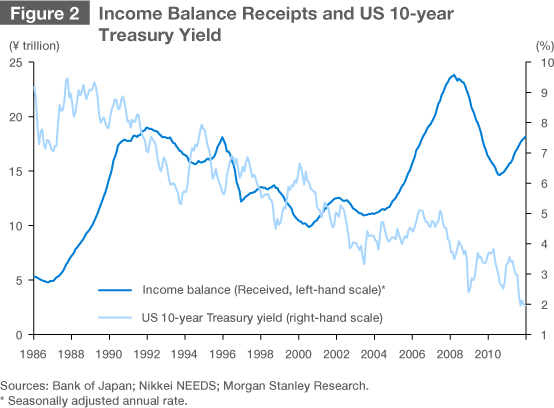
First, among the items in the income account, the ratio of yields on securities have undergone a long-term decline in their share of the total, while dividend receipts are now becoming more prominent. Some of the dividends come from overseas stock investment, but others are a return on profits from manufacturing subsidiaries established in other countries. With the shift of production offshore, the manufacturing sector has seen its exports of finished products decline. At the same time, however, these overseas profit dividends, which are closely attuned to trends in the global economy, have increased. Thus while downward movement in overseas interest rates may squeeze yields on overseas securities investment, the surplus in the income account is being propped up by the growth of dividend receipts.
The second point is that Japan’s net foreign assets have continued to swell even as overseas interest rates have fallen. These additional assets have helped keep the income account in the black at times when yields on securities come under pressure. The net foreign assets stood at about ¥100 trillion 15 years ago but have since grown by 2.5 times, to the vicinity of ¥250 trillion (Figure 3). As a result, even if yields on securities had been cut in half, overall investment returns would still have increased as a result of the growth in net assets by 2.5 times. This shows that a mechanism is in operation that prevents black ink in the current account from being easily influenced by a decline in overseas interest rates.
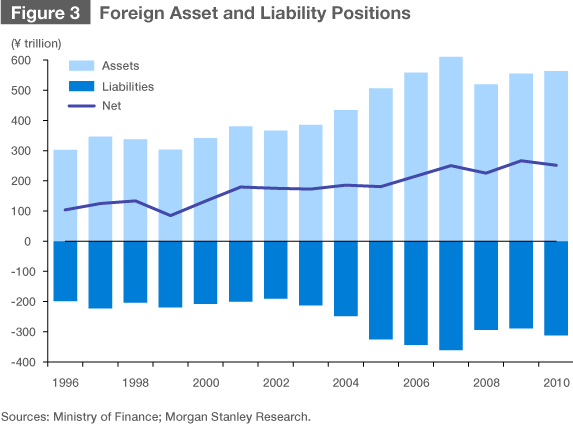
Over the medium to long term we can naturally expect investment managers in the private and public sectors to take steps to boost returns by diversifying their portfolios through investment in Asian and other securities markets with considerable growth potential. In fact, the Ministry of Finance recently announced that it would purchase a modest amount of Chinese government bonds. While this is an example of portfolio diversification in the public sector, it is safe to assume that the same thing is going on in many quarters of the private sector.
Domestic Funds Can Finance Fiscal Deficits
My conclusion, therefore, is that because of Japan’s huge accumulation of net foreign assets, the surpluses in the current account are structurally solid and will not easily turn into deficits. Measured in dollars, these foreign assets have climbed to ¥3 trillion—a level far above the assets held by other countries (Figure 4). If movements in exchange rates are disregarded, a surplus in the current account translates directly into a corresponding increase in net foreign assets. And the larger stock of assets then produces more income gains in the current account.
As long as the current account stays in the black, the government should be able to finance its fiscal deficits solely with domestic funds, relying on the private sector’s excess of saving over investment. A debt crisis, in other words, will not easily emerge. To be sure, a constant effort must be made to bring public finance back into equilibrium, thereby lowering the risk of a fiscal crisis. This is an issue the government leadership views quite seriously. But, unlike the debt crises of southern Europe, there is little likelihood in Japan of debt-financing problems emerging for macroeconomic reasons.
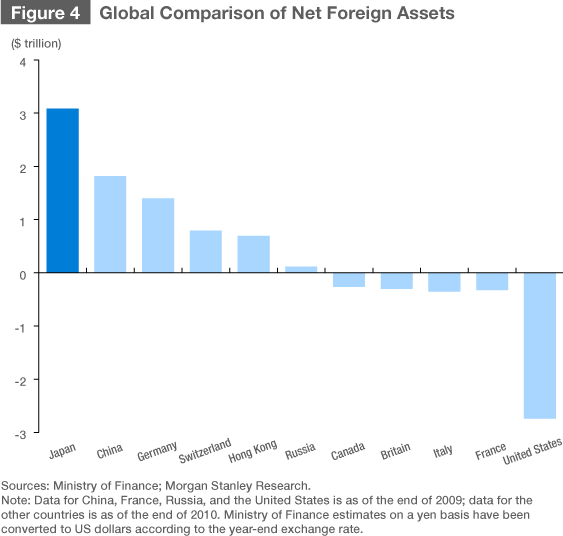
(Originally written in Japanese on March 16, 2012.)
saving fiscal deficit strong yen trade balance Morgan Stanley MUFG Securities current account foreign assets long-term interest rates exports offshore production imports nuclear power station energy imports income account US Treasuries investment